Naked Oceans has reached its 1st birthday and we celebrate by taking a look back at season one to pick out some of our favourite bits. We revisit a major milestone in ocean science with the Census of Marine Life, we venture once more into the depths to uncover some of the challenges of life miles beneath the waves and we call in on the extraordinary mating habits of coral reefs. One year on, we've made a special mixup of critters from the shoal of ocean experts who shared with us there thoughts on which marine species they'd like to be. And we reveal an exclusive glimpse behind the scenes at the making of Naked Oceans.
In this episode
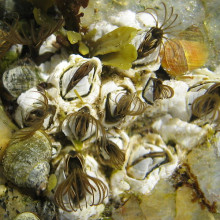
01:16 - Barnacle gene sheds light on foul behaviour
Barnacle gene sheds light on foul behaviour
For as long as there have been manmade boats and ships, there have been marine hitchhikers that have grabbed a ride, sticking onto hulls and causing trouble by increasing drag. Barnacles are the biggest problem and now scientists have uncovered the gene that stops them settling on surfaces painted with a potential new antifouling agent being trialled in the EU - a vetenary sedative called medetomidine.
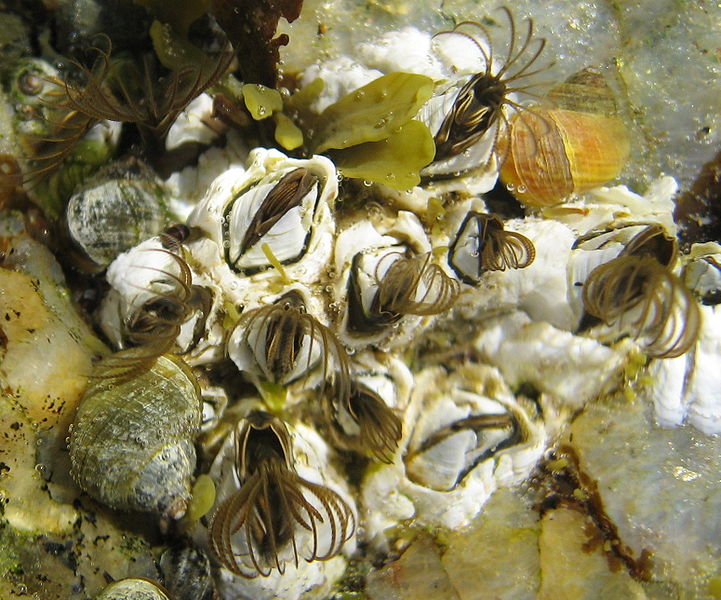 When free-swimming barnacle larvae encounter medetomidine it makes them hyperactive, kicking their legs and wriggling about so they don't settle down and turn into adults. When they swim off, the effect reverses, so the larvae happily move off to settle elsewhere. A research team led by Anders Blomberg from the University of Gothenburg have identified the gene responsible for barnacles sensing and responding to the chemical.
When free-swimming barnacle larvae encounter medetomidine it makes them hyperactive, kicking their legs and wriggling about so they don't settle down and turn into adults. When they swim off, the effect reverses, so the larvae happily move off to settle elsewhere. A research team led by Anders Blomberg from the University of Gothenburg have identified the gene responsible for barnacles sensing and responding to the chemical.
In the past, the main antifouling chemical was Tributyltin, or TBT, but in 2008 it was banned worldwide because of its persistent, toxic effects on marine ecosystems and possibly people too. So, the search has been on for a suitable alternative, and [medder-toe-midine] medetomidine was thought to be it.
But, lab studies published earlier this year by Anna Lenquist, also at the University of Gothenburg, identified possible ecological impacts this new antifouling agent might have including causing fish to loose their dark skin pigments, thus reducing their camouflage against predators, and affecting their livers.
While it's unclear just whether medetomidine will leach into the marine environment in significant quantities to have any impacts, this suggests that we need to tread carefully.
Hopefully understanding the molecular pathway that keeps barnacles at bay, should lead towards highly selective treatments that only affect these unwanted hitchhikers while leaving the rest of the marine world well alone.
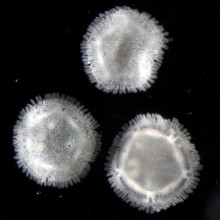
03:29 - Making a young star of Xyloplax
Making a young star of Xyloplax
A group led by Daniel Janies from the Ohio State University have used molecular sequencing, developmental data, and supercomputers from the Ohio Supercomputer Centre to solve a taxonomic problem involving echinoderms...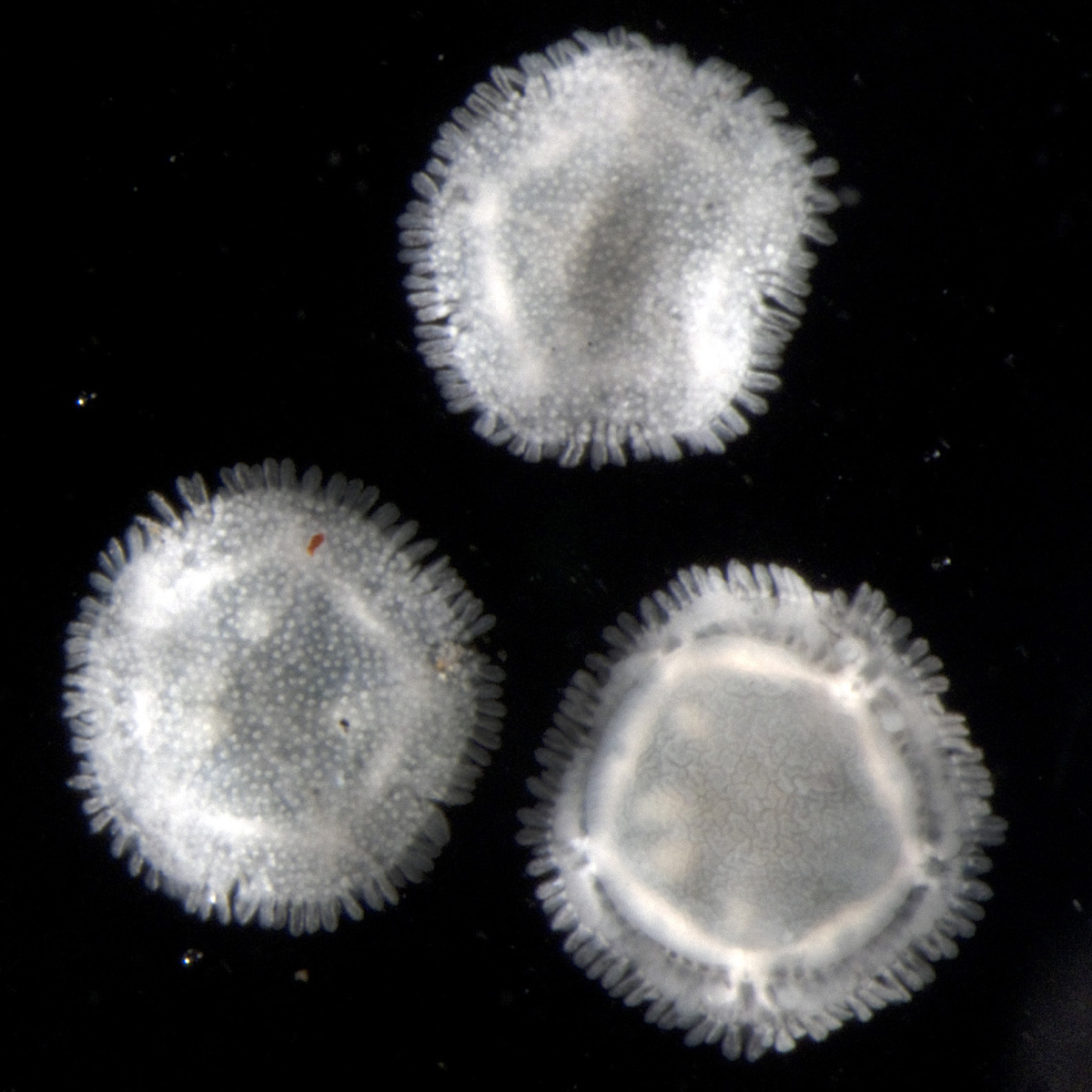
Echinoderms include creatures like sea urchins, starfish, sea cucumbers and sea lilies. But how the different classes of living echinoderms are related to each other has caused problems over the years, with one particular deep sea specimen giving taxonomists a headache. It's called Xyloplax, and it's a tiny, disc shaped animal, about 4mm across, found in the deep sea around New Zealand and the Bahamas. It didn't fit with the body plans of other groups, so it was placed in a separate class of its own - a sixth echinoderm class, alongside Asteroidea (which are the starfish), Ophiuroidea (including brittle stars), Holothuroidea (which are the sea cucumbers), Echinoidea (sea urchins) and Crinoidea (the sea lilies).
But now a group led by Daniel Janies from the Ohio State University have used molecular sequencing, developmental data, and supercomputers from the Ohio Supercomputer Centre to show that actually, Xyloplax belongs within the Asteroidea, with the starfish. They examined specimens caught by Janet Voigt, another of the paper's authors, to show that Xyloplax broods its young in a special chamber, just like other groups of starfish, and study its development. And they were able to extract genes from the specimens to compare with 86 other echinoderm species and non echinoderm outgroups, to create a phylogenetic tree, which places Xyloplax with the starfish.
But why doesn't it look like a starfish? 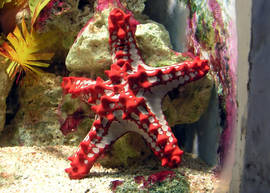 Well, Janies and his colleagues suggest Xyloplax's circular appearance is due to a process called progenesis, where individuals reach sexual maturity whilst retaining their juvenile body plan. Progenesis, along with another process called neoteny, are examples of paedomorphosis, where adults of a species either retain features of juveniles (in neoteny - an example of this would be the external gills on an axolotyl) or completely retain the juvenile body plan, whilst being sexually mature, which is progenesis, as is the case here. There aren't that many robust examples of paedomorphosis in nature, but it has been suggested as a route that vertebrates could have evolved by, and in human evolution too. So having more examples of it will hopefully allow us to understand it better.
Well, Janies and his colleagues suggest Xyloplax's circular appearance is due to a process called progenesis, where individuals reach sexual maturity whilst retaining their juvenile body plan. Progenesis, along with another process called neoteny, are examples of paedomorphosis, where adults of a species either retain features of juveniles (in neoteny - an example of this would be the external gills on an axolotyl) or completely retain the juvenile body plan, whilst being sexually mature, which is progenesis, as is the case here. There aren't that many robust examples of paedomorphosis in nature, but it has been suggested as a route that vertebrates could have evolved by, and in human evolution too. So having more examples of it will hopefully allow us to understand it better.
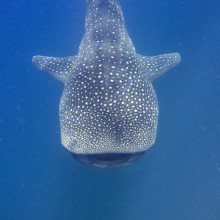
05:53 - Uncovering a whale shark extravaganza
Uncovering a whale shark extravaganza
Scientists in Mexico have discovered the largest mass gathering of whale sharks in the world.
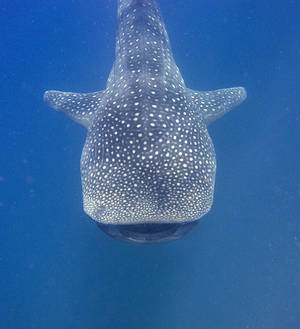 These gentle giants can grow up to around 12 metres or 40 feet in length, which means spotting just one of them as they cruise the oceans is an unforgettable experience. Imagine what it must be like spotting a gang of more than 400 whale sharks?
These gentle giants can grow up to around 12 metres or 40 feet in length, which means spotting just one of them as they cruise the oceans is an unforgettable experience. Imagine what it must be like spotting a gang of more than 400 whale sharks?
That's what a team of researchers from Mexico and the US did back in the summer of 2006, when the huge aggregation site, which they've named Afuera, was spotted from a plane flying off the coast of the Yucatan Peninsular in the Caribbean Sea. Since then they've been back each year to carry out studies from the air and in the water to try and figure out what's going on. And in 2009, they spotted the largest aggregation of 420 sharks in an area covering just 12 square km.
The big question is, why do whale sharks do it?
When any animals group together en masse there are really only two possible explanations: sex or food. And in the case of the whale sharks at Afuera, and elsewhere, where other, smaller aggregations form, it turns out it's the latter.
Whale sharks gather at Ningaloo Reef in Western Australia to feed when the coral reefs undergo mass spawning. At another aggregation in Belize, whale sharks are after the eggs of Dog snappers that also spawn in aggregations.
At Afuera, the research team sieved the sea for plankton and found that is was awash with fish eggs. And DNA barcoding revealed that they're a type of tuna called the little tunny. These eggs come packed with fats, making them superb whale shark food. And it's thought that the reason the tuna show up and spawn in this spot is thanks to the upwelling along the coast that injects a pulse of nutrients into the ecosystem.
There's another, smaller aggregation close to Afuera that's been known about for a few years and has recently been protected by the Mexican government. That one already draws in flocks of tourists who - quite understandably - are keen to swim with the biggest sharks in the ocean.
But researchers are worried that this could cause problems with collisions between sharks and high-speed boats. So they're calling for swift action to protect the animals in this extraordinary natural event, and so hopefully they'll still be there for generations to come.
Find out more
An unprecedented aggregation of whale sharks, Rhincodon typus, in Mexican Coastal waters of the Caribbean Sea
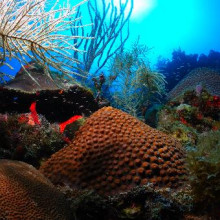
09:08 - The Census of Marine Life
The Census of Marine Life
with Jesse Ausubel, the Sloan Foundation; Sylvia Earle
Helen - A major landmark in ocean science was reached in October 2010 with the completion of the world's first Census of Marine Life. It was 10 years in the making, involved hundreds of scientists all across the globe who joined forces to take on the enormous challenge of discovering as much as possible about the abundance, diversity, and distribution of life in the oceans. Sarah and I went along to a special conference in London that celebrated the achievements of the Census. To find out how the whole thing got started, we chatted to Jesse Ausubel from the Sloan Foundation about a very big idea he had a little over 10 years ago...
Jesse - On July 2nd, 1996, a deep sea expert named Fred Grassle said, "I think something big needs to be done for marine life, for marine biodiversity," and he said "obviously that's because over-fishing, pollution problems, but also because so much remains to be discovered."
He had published an estimate, that there might be between 1 and 10 million forms of marine life. And so I said, "Well Fred, give me a list of what's actually known today," and he was embarrassed.
He said, "I can't give you a list. We don't have one." And I said, "But people have been doing marine biology since Aristotle for 2,500 years. How come you'll not have a list? There must be a textbook with a list of all the forms of marine life" and he said, "Well, you know, the sponge people have their lists but they don't always agree with the corals people, and they don't talk to the anchovy people, and the anchovy people don't like the tuna people, and the tuna people don't like the shark people because sharks sometimes attack tuna..."
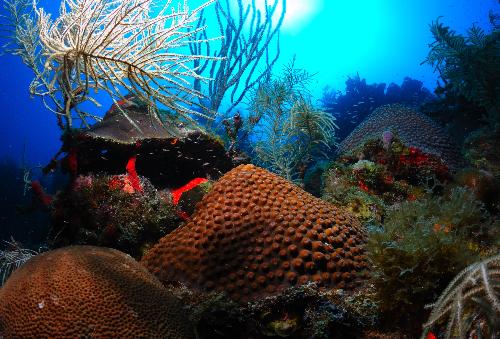 So, there's a lot of information but it's just not organised and most of the ocean is unexplored. So we talked for about an hour and a half, but the end of the hour and a half, we had the idea to have a big observational program in which we'd have hundreds of expeditions, and really try to get better, real information and observations, and Fred also had the basic idea and said, "But we have to have a common database, so the anchovy people and the sea star people, and the herring people can't all just go off in different directions, so we really want to know everything."
So, there's a lot of information but it's just not organised and most of the ocean is unexplored. So we talked for about an hour and a half, but the end of the hour and a half, we had the idea to have a big observational program in which we'd have hundreds of expeditions, and really try to get better, real information and observations, and Fred also had the basic idea and said, "But we have to have a common database, so the anchovy people and the sea star people, and the herring people can't all just go off in different directions, so we really want to know everything."
So, we both thought the idea was wonderful and we went off in separate directions and started talking to our colleagues about it. Most people said the idea is wonderful and most people said the idea is crazy. Some of them said it's romantic. Some of them said it's impossible, but no one said, "Don't try to do it." It made people somehow smile or laugh that we wanted to count all the fish in the sea.
So we had 3 whole years of feasibility studies during 1997, '98, '99. We did do our homework. We had lots of consultations. We wanted to make sure that the technology was powerful enough, we wanted to make sure that people would cooperate. We wanted to make sure that if we finished, as we've now done, that people would feel it was worthwhile. So, we had 3 years of feasibility studies. At the end of which, more people felt it was a great idea and some people still thought it was crazy. But fortunately, the people with the check book at the Sloan Foundation said, "Well we should take risks. That's why we're here. We're not like a federal government agency. We should take a chance on something." The president and the trustees of Sloan said, "We will support this program for 10 years, as long as it meets certain milestones."
And that's very important because if you talk to lots of Naked Scientists, you know that it's hard to get clothing for more than one year or two years at a time. It's very hard to get long term commitments. So the fact that one organisation, even though it couldn't provide all the money - in the end it provided 12% of the money - it said, we will be steady. We will provide basic support every year as you walk and talk to each other, coordinate, make your plans and if you do well, each year, we're just going to keep supporting you until you finish in 2010.
In 2000 we started organising and Fred's view was that we should get into the water quickly. We'd already had some years of feasibility studies but we said, with many programs - you write a plan and then you write a plan to write a plan to write a plan... And people spend 10 years planning and never get to the water or launch a rocket.
And so Fred said, "Let's start doing things right away!" Showing the kinds of work that we think should be done, and then try to attract people to the project by example rather than just inviting people to write documents. And so, we started right away, immediately in 2000, 2001 with some expeditions in which we try to again show that we were interested not only in the squid, but we we're interested and what lived on the bottom, and we were interested in sea birds, all of the different forms of marine life. And people became enthusiastic. In the end, almost everyone participated even though we never went out and dragged people in. It was a kind of voluntary Noah's Ark. So, the abyssal plains people, and the sea mounts people, and the reefs people, they just kind of started to come to us and say, "we want to be part of this" and it grew, and by 2004, 2005, we basically had all the different habitats and the different species represented.
Helen - And I can see by grin on your face that it's clearly a wonderful experience to be here, stood here 10 years down the line with your crazy, romantic, impossible project finished?
Jesse - It's been the best experience of my professional career and maybe the best experience of my life. I feel a little bit like an Olympic diver who chose a very hard dive and then you do the triple somersault and it worked, so I have a little bit of that feeling today. So I'm very proud. Of course, I'm proud because what we've done is important also because it's not easy being a fish these days and we should be a lot more sensitive about how we treat life in the oceans.
Helen - Jesse Ausubel, the co-founder of the Census of Marine Life, telling me, Helen Scales about how the whole grand project got started.
Sarah - We really did have a fantastic time at the Census Conference and not just because of lots of champagne. It was great to meet so many scientists who dedicated themselves to studying the ocean - from people using DNA bar-coding to indentify tiny critters, to those tracking the global migrations of ocean giants like sharks and whales, and we got to meet one of our absolute heroes, the legendary explorer, Sylvia Earle. Here's what she had to say about the Census.
Sylvia - It's been said several times and I'll say it again. This is a wonderful beginning. Ten years is a long time and it has set the stage for whatever follows. This really has stirred things up and makes it perfectly obvious that the great era may be the greatest era of exploration is truly just beginning.
Some think that it's all over, that we have to reach skyward to find new frontiers and of course, we can find them there. We need to do that, but mostly, we need to get to know this part of the universe. This part of the solar system, this place that keeps us alive. It's critical in terms of that great dream of human kind and that is to have peace. We cannot have peace among ourselves if we failed to have peace with nature, and we're not. Right now, we're not. We're cutting forests that have been growing for thousands of years. We're mining the ocean of its wildlife that has been developing for hundreds of millions of years, and I can forgive it only on the basis that people just don't know. They don't know and yet, we have the power of knowing and the Census of Marine Life has gone a long way toward putting things in perspective that not only have we just begun to get to know this ocean planet and to appreciate that our lives are dependent on the ocean and the creatures. It's not just rocks and water out there. It's a living system that gives us oxygen that grabs the carbon out of the atmosphere, that drives the food webs, drives not just the carbon cycle and the oxygen cycle, but the water cycles. It's where 97% of the water on the planet is and without the ocean, no rain, no water, no life. We absolutely are dependent. We are sea creatures, every bit as much as those magnificent numbers of individuals that the Census of Marine has been cataloguing and celebrating at this occasion.
Helen - That was the wonderful Sylvia Earle, pioneer of deep sea exploration. She's spent thousands of hours underwater and still holds the record for walking on the seabed deeper than anyone else. She ventured down 400 meters inside a diving suit called JIM back in 1979.
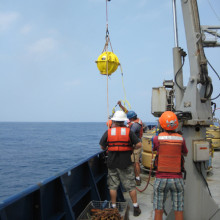
18:21 - Deep sea challenges of microbes and men
Deep sea challenges of microbes and men
with Professor Douglas Bartlett and Kevin Hardy, Scripps Institution of Oceanography
Sarah visits the Scripps Institution of Oceanography in San Diego, in the US, to find out how masses of marine microbes deal with the challenges life in the deep. And she gets to play with some high-tech gadgets that bring samples of the deep sea back to the lab.
Douglas - There's so much diversity of microbial life in the ocean in general and especially in the deep sea and we just don't know a lot of what's there. So there's all this biology that's just waiting to be explored. And so we've been taken up with that.
I have been told of this quote that came out of the Census from Marine Microbial Life that there's something like 30 full frown African elephants-worth of microbes for every man, woman, and child on the planet. And most of those microbes in the ocean are in the deep ocean. Maybe not in extreme deep ocean environments but found at depth.
So there's a lot of diversity of life down there. We're interested in the adaptations of microbial life to deep ocean sediments because they are so different - they're dark, the way microbes get nutrients in the deep ocean is very different from that in surface waters, they're adapted to low temperatures as a rule, and they're adapted to high hydrostatic pressure. And it's this last parameter, high pressure, that we've really been focusing on.
And it would be wonderful to be able to get those organisms into culture to more easily do biochemistry and genetics. It would also be useful to look at their genomes and do culture independent molecular analyses, and to look at processes like CO2 fixation and other biogeochemical cycles.
Sarah - So, if you look at something like a bacterium or a microorganism, something that's very small, do they face different challenges to the high pressure than something like a larger bodied animal?
Douglas - The general problems that a microbe would face would be very similar to the cells of any organisms, an invertebrate or a vertebrate. It all has to do with high pressure influences on volume changes, on equilibria, activation, so biochemical processes are very different under high pressure. And all organisms are going to face that issue.
Sarah - And so how do they get around these issues. What adaptations have they come up with that help them solve it?
Douglas - The most well-studied adaptation has to do with membrane lipids. The membrane lipids of deep ocean organisms - fish the bacteria - are loaded with highly unsaturated fatty acids. And that's critical to keeping the membrane in the right physical state - a semi-liquid state. So that it can function for transport and for energetics and for other processes.
Sarah - So, how exactly do you go and retrieve samples of these things? Is that what you do, you go and then you bring them back and study them in the lab? I guess you can't necessarily study them in situ because you just look at them and think I don't really know what's going on there?
Douglas - Yeah, it's hard to explore microbial activities and processes in situ. But that's a growing area of development in the ocean sciences that is coming up with more autonomous instruments that allow you to go where you need to go and to measure those parameters that you'd like to measure.
But what we usually do is, we work with an engineer here at Scripps who comes up with these wonderful untethered toys that can be deployed from relatively small ocean craft and sink all the way down to the deepest ocean depth and can be used to collect water samples and mud and to collect animals using baited traps, and things like that.
And after a prescribed time will release their ballast, close the doors of whatever they're sampling, sea water or animals like crustaceans, and come back up to the surface. And we get those samples at the surface and then we process them.
So far it's been valuable. We've been getting new kinds of microbes. In some cases not just new species or genera of microbes but even new sub-phyla and phyla of microbes coming up that hadn't been cultured previously from deep ocean environments.
Sarah - And finally, I spotted earlier that little tiny polystyrene cup on your window sill. Is that something that was taken down in one of these little unmanned subs?
Douglas - What a great question! You know, I don't even remember where this came from. It is either came from one of those small untethered instruments or it looks like in this case it came from a dive with the Alvin submersible. And so that probably went down just a couple of kms in depth.
But some of these instruments that we deploy have been used at depths as great as 9km or so.
Sarah - So I'm guessing this was once a normal sized polystyrene cup and it's now the size of a very mall egg cup. It's an illustration of the pressures that we're looking at, I suppose.
Douglas - It is. It is. This is a perfect example of how high pressure promotes volume decreases and it does that to a Styrofoam cup. The Styrofoam cups get compressed to something like ceramic and greatly decreased in size.
Sarah - So I guess that is a great illustration of the problems that microbes like that face in the deep sea.
Douglas - It is. And also for people who want to deploy instruments in the deep ocean. Because everything ahs to be designed so that it can cope with high pressure. So, pressure housing are necessary for every component of equipment that gets deployed down deep. Whether it's a manned submersible or an autonomous instrument, or some cabled array, is all has to be pressure resistant.
Sarah - Well, speaking of taking stuff down to the deep ocean and how exactly we go about looking at all the microbes and all the life down there, we're now joined by Kevin Hardy. Kevin, hello.
Kevin - Hi.
Sarah - So I hear that you have quite a lot of exciting gadgets and instruments that you might be able to show us?
Kevin - We have some of the tools of science that get us down to the deepest ocean depths. So, just across the hall...
Sarah - Let's go. Let's go.
Wow, this is quite an exciting room full of gadgets and big yellow spheres. What exactly am I looking at here?
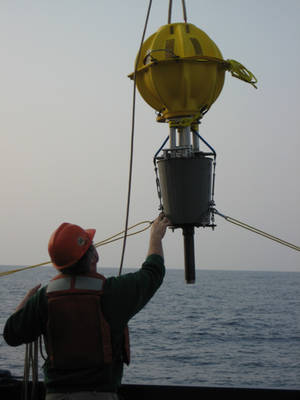 Kevin - This here is actually is one of our deep ocean vehicles. It's a small 17-inch outside diameter glass sphere with an acoustic transponder up on top so we can acoustically communicate with it at depth. And gives us about 54 pounds of buoyancy as well as command control so that gives us a payload capability which means we can haul stuff down to the deep ocean.
Kevin - This here is actually is one of our deep ocean vehicles. It's a small 17-inch outside diameter glass sphere with an acoustic transponder up on top so we can acoustically communicate with it at depth. And gives us about 54 pounds of buoyancy as well as command control so that gives us a payload capability which means we can haul stuff down to the deep ocean.
Sarah - And then haul stuff back up, I guess?
Kevin - And then haul stuff back up, yes. It should be a round trip. So we have one of our frames right here. We actually try to use fiberglass reinforced plastic, FRP, because the water weight is so much lighter and then we attached plastic bottles onto here. So even though it looks large, underwater it really weights nothing so we can carry large volumes of water back to the surface.
Sarah - Well, it's quite noisy in here so shall we take a couple of your exciting gadgets back to the office and we can have a a look at them in more depth. As it were. Fantastic pun there!
Kevin - So, we have a few things we do. Each of the vehicles is a composite of a variety of technologies and we're experimenting with some new ideas. These are lithium ion batteries which are actually really cool because they're vacuum packed and you can see it's sort of like a Ziploc bag that hold a jelly sandwich.
Sarah - Oh yea. So that's pretty small. It's about 3 or 4 inches long, it's about an inch wide. How much power does that thing give out?
Kevin - Yes, this will give us quite a bit actually. It's almost 12 volts at about 2 amp hours. So you can really pack a lot of punch. But the other great thing about this you can package these in an oil environment so they're pressure compensated, and we've done that running them down to pressures greater than the deepest ocean depths. So we can put these outside and we never have to open up those glass spheres on board the small ship, so it makes turnaround very easy.
So we're excited about that, so rather than bringing water up to be processes on the ship we can bring our little factory with us down to the sea floor and leave it down there for a long period of time and actually get a lot more of the microbes that we're looking for.
Sarah - So obviously pressure is something that these are calibrated for. Is pressure the major problem that we look at when we're going down to study the deep sea?
Kevin - Yeah, it's really the first order problem because it'll effect your buoyancy so it's really a buoyancy game - it's like having a lift to the deep sea. So we can put a big anchor on these things, send them down and we have to design them to either tolerate pressure or to be stronger than the pressure.
Once you're down there it's actually pretty benign, temperatures are fairly constant, there's no light to deal with, currents are pretty nominal, corrosion is one of the problems we have to deal with - so a secondary problem. But those things are easily engineering around. So we've got some experience doing this.
So, some of the problems remains the same. The core extraction problem is the one where we go down and get sediments from the seafloor. It's well known that it's like trying to take a core sample out of peanut butter. You plunge in a core tube and you pull it out and it really has a lot of adhesion.
So, one of the techniques that was first proposed in 1960 was by a guy named David Moore here in Sand Diego. And that was actually a technique where you take a steel core tube and it's lined with a plastic sleeve.
Sarah - Oh I see. So this is kind of, it's almost like a drainpipe size, a metal tube here and it's surrounded with this rather sturdy looking plastic rings and things. How does this work?
Kevin - Well, this is really great because what he decided to do was rather than fight the sea floor he was going to give it up. And what he did was he took this steel tube and it would go down to the sea floor, hit the bottom and then the mud would push up on this release and would leave the steel tube behind. And then draw up the plastic liner and leave the steel casement in the bottom which actually rusts away in a short period of time and it's fairly cheap.
That works out actually pretty well, especially for free vehicles when you only have a limited amount of buoyancy.
Sarah - So I guess one of the problems is not just being able to get the sample into your machine it's being able to get the machine off the seafloor because I guess it's like getting stuck in that goopy mud at the beach where you get your feet stuck and you can't out and you're making that splatchy noise. But you're obviously under so much pressure under the sea as well, so I guess it's a bit of a problem.
Kevin - It is. Some of the core samples have a line that goes all the way back up to the ship with a big powerful winch. They can haul this thing with hundreds of pounds. But with the free vehicles which are really just remote vehicles that go down on their own, all you have on board is the buoyancy you have which might only be in the order of 40 or 50 pounds. And so we had to become a little more clever about how to get our vehicle back.
Sarah - And is this still a system that's still used today?
Kevin - Oh yeah. We just used on the Philippines Sea. It's been used down in Fiji. It's really the best way to go, I think. It's still something of the holy grail for us to get this working perfectly every time. But once we do that we have microbial scientists working here on new medicines from the sea, both antibiotics and actually cancer cure drugs, and they really need to harvest the sediments to find those animals. And so they're very good at that, I' very good at this, together we can do things that really help mankind.
Sarah - And we're talking about all these untethered, unmanned vehicles. But have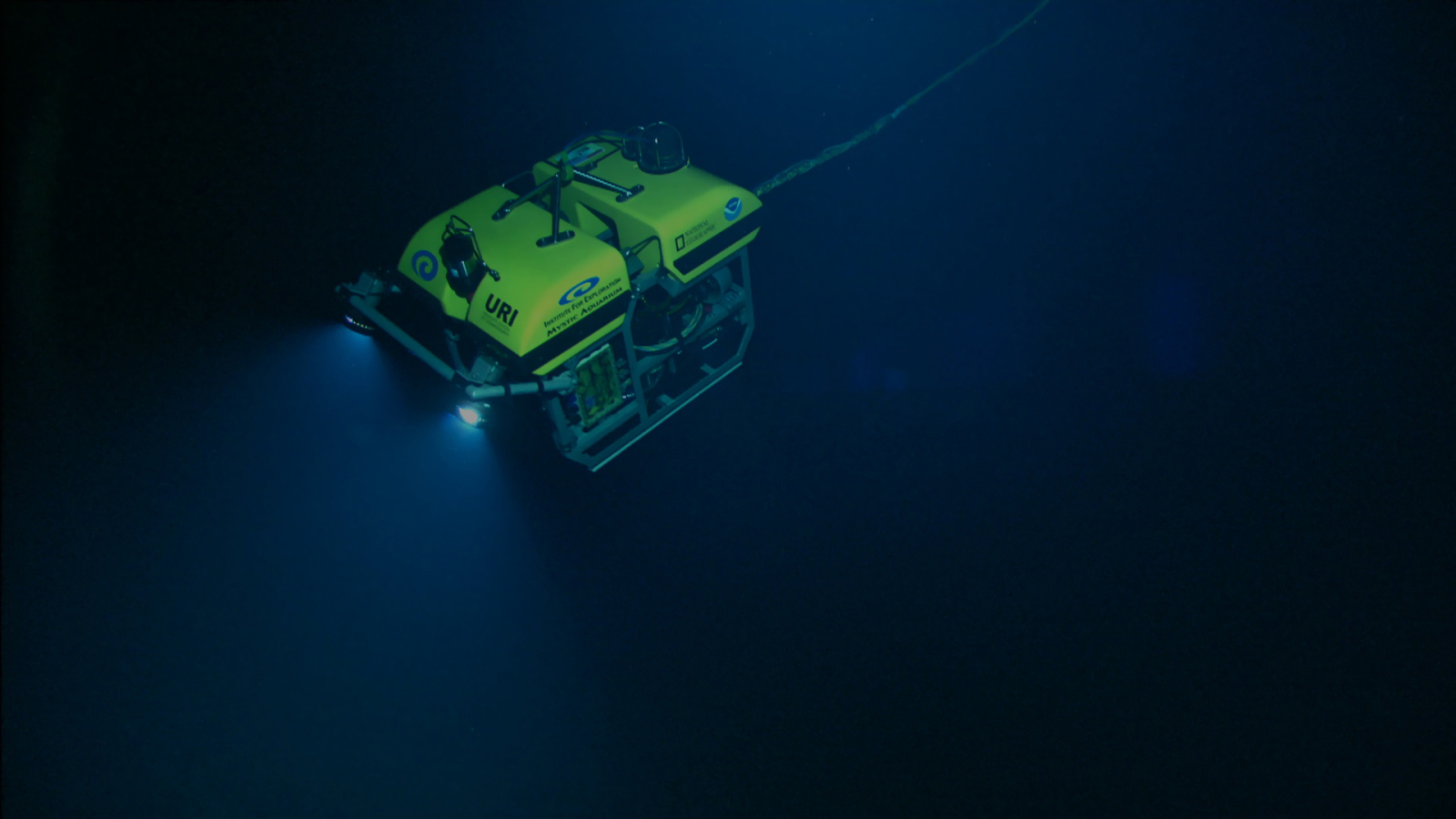 either of you ever been down inside something like the Alvin submersible where I guess you get packed into this tiny little room, have either of you ever been down in one of those?
either of you ever been down inside something like the Alvin submersible where I guess you get packed into this tiny little room, have either of you ever been down in one of those?
Douglas - I have, I've been down on a few dives in the Alvin, and it's a wonderful experience looking out that porthole. In my case we were looking at cold seeps off the NW coast of the US. Beautiful trip. It's cramped in there, as you indicated. You have three people crammed in an uncomfortable position, everybody trying to look out the porthole window.
And there are real advantages to being right there when it comes to sampling and thinking about the science that you're going to do.
Kevin - So I've been down in a couple of smaller submarines, not the Alvin. And it's quite an experience, first hand observation. Roger Revelle, our former director, once said that instruments will only see what you tell them to look for. So if you're measuring temperature, that's what you get. So, having a human eye behind the portal is really pretty nice. The great thing about free vehicles, unmanned vehicles, is there persistence - they can stay down there quite a long time, 2 years perhaps. If you want to study an entire annual cycle of the deep ocean you can do that. Whereas manned vehicles the great advantage is the human eye and their mobility.
We're picking up some more mobility with AUVs which are like a first order solution to survey a large area. But I think still that there's still quite a bit of opportunity for manned observation down deep.
It's really an exciting place to be. It's a whole other planet. It's a whole other earth. Things happen there that don't happen topside - spreading centers, subduction zones, all sorts of weird and strange animals, many of which we've yet to find. Every time we go down with a camera we find something brand new with samples, we find something brand new. It's still a remarkable place to go.
Find out more
Professor Douglas Bartlett's lab at Scripps
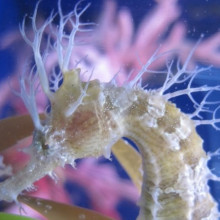
33:49 - Supplying the seahorse trade
Supplying the seahorse trade
with Shawn Garner, Mote Marine Laboratory
Helen - Every year millions of dead seahorses are traded as Traditional Chinese Medicines. They're thought to be a remedy for all sorts of conditions from broken bones and asthma, to kidney complaints and even a flagging libido, and conservationists are worried this is putting too much pressure on some wild populations.
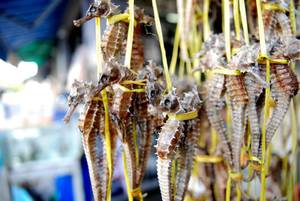 There is also a roaring trade in live seahorses for public aquariums and for people who want to keep them at home as pets.
There is also a roaring trade in live seahorses for public aquariums and for people who want to keep them at home as pets.
So, I paid a visit to Mote Marine Laboratory in Sarasota in Florida, to find out how breeding seahorses in captivity is offering a way of cutting down on the number of seahorses we take from the wild every year.
Here's supervisor of Mote's Seahorse Conservation Lab, Shawn Garner.
Shawn - This is a laboratory that's on exhibit to a public aquarium 300...
Helen - In fact we can see people walking right by now, peering in the window...
Shawn - And waving, yes. So education is key. We want to show children and adults 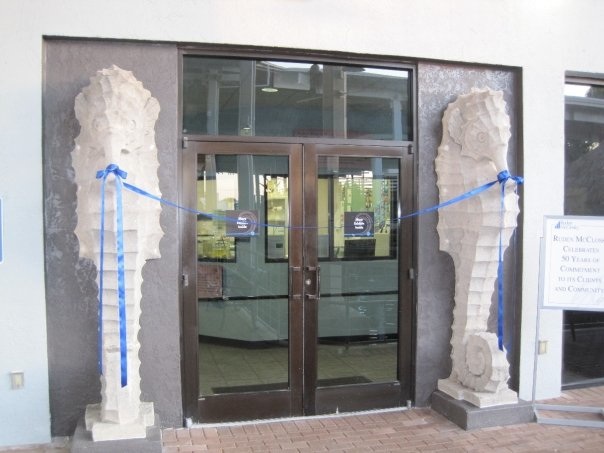 seahorses because it is the coolest animal in the world.
seahorses because it is the coolest animal in the world.
Helen - I'm glad you agree with me on that.
Shawn - There's no other animal that has a head like a horse, eyes like a chameleon, pouch like a kangaroo, tail like a monkey. And it's a fish that has the only true male birth. That is the coolest.
But the really main thing about this laboratory is breeding seahorses, learning how to do it, and sharing that information with other facilities so that they can breed seahorses.
We're breeding them for other zoos and aquariums around the country do they don't have to collect from the wild.
Helen - That's great, so how long will you keep seahorses here before you send them off to other aquariums?
Shawn - We wait for about 6 months, 8 months is ideal when we ship. And we ship all around the country and hopefully around the world sooner or later.
Helen - How do you send a seahorse? You send them by plane I take it?
Shawn - Yeah, actually we use Fedex. We put it in a bag of water, one third really clean water, two thirds pure oxygen. I put 3-4 seahorses in a bag and I give them a toy. Because anyone who has driven around with kids in the back, they hit each other, they mess with each other, and I don't want that stress. So I give each seahorse a toy to hitch onto and that's kind of like their protection.
And then they're triple-bagged, put in a Styrofoam shipping container, then there's a heat pack or cool pack, and we ship them overnight. We've shipped a thousand or more seahorses and maybe had one problem but it's been really good, and the horses arrive there perfect.
What we're looking at is the brood stock. And the brood stock means that they're animals just for breeding. They're here, they're my best seahorses right now.
Helen - They're the studs?
Shawn - They're the studs, and the queens, I guess. They have good genetics. They're usually wild caught. Now I'm legally allowed to take a few wild caught seahorses from the environment. So really all they're here doing is breeding and eating. And it happens in the morning. They go up in the water column, they either do their mating dance or they transfer eggs, and then they kind of leave each other alone the rest of the day.
Helen - And, how often will they actually have babies?
Shawn - The male will get pregnant, of course. His gestation is about 25 days. He will release the babies and pretty much the next day or two days after, he's pregnant again. And this happens pretty much his entire life from 6 months all on up to about 4 years, and he is pregnant most of his life.
Now, he gets pregnant so much he can actually fake being pregnant.
Helen - This is news to me!
Shawn - Yeah, he can actually inflate his pouch with water and tell his girlfriend or his wife 'I'm pregnant already, I can't accept your eggs this month'. And she will actually dump her eggs on the ground, which is terrible because it takes 40% more energy to create the eggs than to gestate them.
Helen - Wow, that's crazy. Okay, so we have, these are the mums and dads basically. And then the babies come, and then these are the guys over here? These are some of the newborns in this tank? Well, you haven't got any tiny ones, but these ones here?
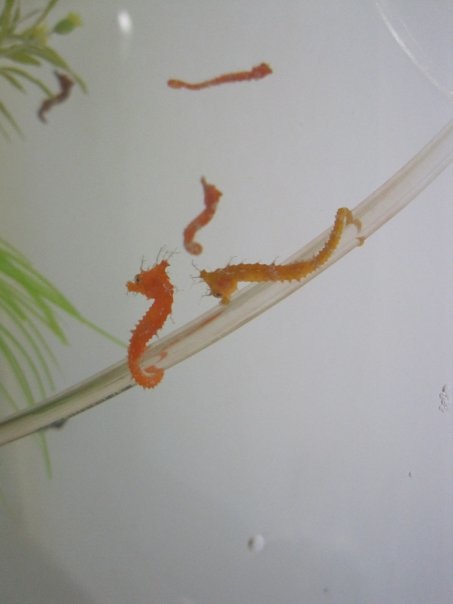 Shawn - Yeah, we didn't have seahorse babies last week, but we had some two weeks ago and we're looking at them right now. It's a brood of probably 100. We're looking at Hippocampus erectus, the lined seahorse.
Shawn - Yeah, we didn't have seahorse babies last week, but we had some two weeks ago and we're looking at them right now. It's a brood of probably 100. We're looking at Hippocampus erectus, the lined seahorse.
So what they're doing is they're circulating around the tank. They're in a specially designed tank called a Kreisel or Gyro, and it's a tank designed for animals that are planktonic, that are floating in the ocean, we like to tell the kids planktonic means 'Go with the flow'. So they're circulating and they're eating the smallest food that we have, and we actually grow plankton here. And they're eating it and they're swimming and that's all they're doing right now.
Helen - And in this tank here there are some equally as tiny animals, but they're a bit older, aren't they?
Shawn - Yeah, these are Hippocampus zostera, the pygmy seahorse. And, very small animal, one inch is pretty much max. They only have 10-12 babies at a time, but they have one of the largest babies of any other seahorse, and they're pretty smart. There are so smart that when we try and take them out of their parent tank they can run away from the net. They know a net is danger. They're very smart animals, I love these guys, they're so cute.
Helen - They are amazingly cute. They're so tiny I can hardly see them. Awesome.
Seahorses are pretty sensitive aren't they, to their conditions in which they're living. The water has to be the right salinity, temperature and so on, and they are kind of susceptible to getting diseases too, that's the case, right?
Shawn - Like any animal they can get stressed out. Just like humans, you get stressed out, and when you get stressed out you're more prone to getting a cold or the flu or what have you. Yeah, seahorses are very prone to diseases and bacteria. So we try to provide the most calm environment for them.
We found out lately that sounds are huge in the seahorse world, that load sounds, motor sounds and vibrations from the world causes seahorses to become stressed out which I turn gets them not to reproduce as much, not live as long.
When we built this lab we specially chose the pumps, the lighting, all the filtration so that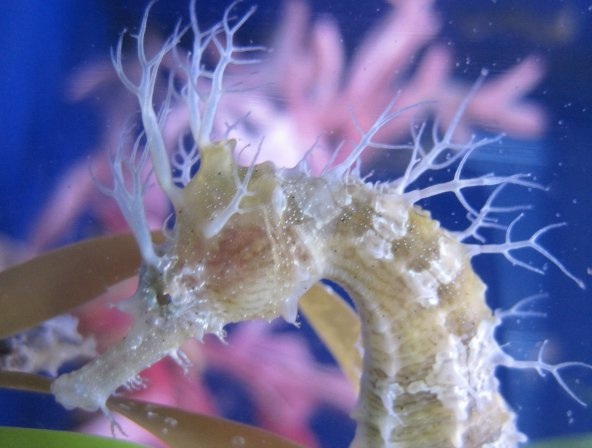 everything is vibration-free, there's not a lot of metallic sounds in the water. And it's really, hopefully, proven to be a great thing. A lot of zoos and aquariums have big tanks that have really strong pumps and concrete and vibrations, they have a lot of problems keeping seahorses alive. Well, we keep them alive and we breed them in their thousands. So, I think the vibrations and the sounds are really important to seahorses' survival.
everything is vibration-free, there's not a lot of metallic sounds in the water. And it's really, hopefully, proven to be a great thing. A lot of zoos and aquariums have big tanks that have really strong pumps and concrete and vibrations, they have a lot of problems keeping seahorses alive. Well, we keep them alive and we breed them in their thousands. So, I think the vibrations and the sounds are really important to seahorses' survival.
Helen - You've been operating on seahorses?
Shawn - Not me, but we have a vet that actually did one of the first laser surgeries on a seahorse. We had one seahorse a year or two ago that grew a tumour on its tail.
What we did is, we grabbed the animal, and we actually put it under, under anesthesia.
Helen - Oh my gosh, how did you do that?
Shawn - We took it out of the water, and put it on a tray and ran a tube into its mouth that pumped anesthetic water and it went right past his gills and put him under. He was dry but he was still breathing and he was knocked unconscious.
And so the vet got the laser out, turned the setting to the lowest setting because he was so worried how frail a seahorse is. And tried to take the tumour off - didn't work. So he raised the level up a little bit more - no go. He had to raise the level up so high it was the same as turtle shells, and then he was able to take the tumour off. And so we took that seahorse and put him back in his regular water, he woke up, and he survived another year or two after that. It was amazing, it was so neat.
Helen - That is very cool. Seahorse hospital, here we are.
Shawn - Yeah, we'll do anything to keep them alive. It's important.
Find out more
Mote Marine Laboratory
Hippocampus zostera on Fishbase
Hippocampus erectus on Fishbase
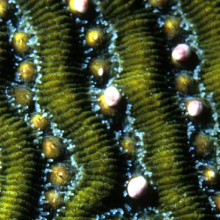
42:10 - Coral reef mass spawning
Coral reef mass spawning
with James guest, National University of Singapore
James - It's a pretty spectacular event, particularly you only see if at night time. And just before the spawning , you know, nothing is really happening it's very quiet. There's no activity, and then suddenly you have within a period of about half an hour, you'll start to see bundles of eggs and sperm, they're small bundles, they're a few millimetres 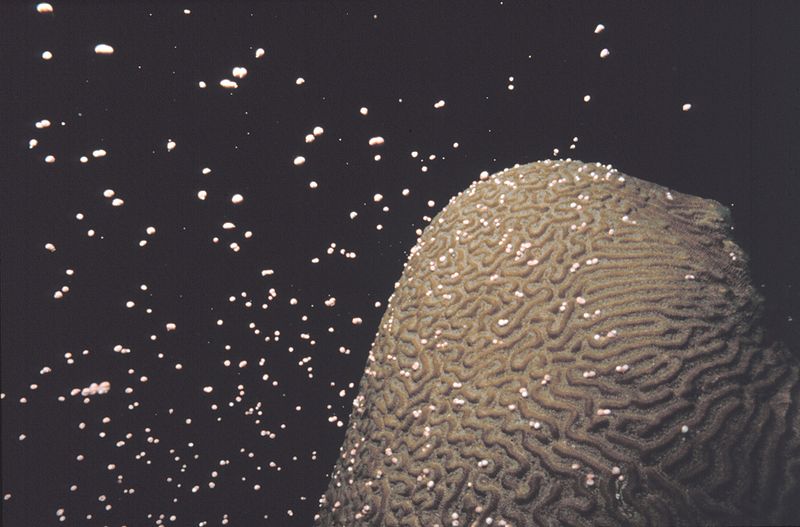 across, they're often pink or red or orange. And they start to be released from many colonies at the same time and also often many species at the same time. And the effect is something like a sort of a snow storm in reverse, upside-down. So you can imagine at night-time, with all these brightly coloured bundles all being released the effect is very spectacular. It's something like perhaps being in one of those snow globes, those little toys that children have.
across, they're often pink or red or orange. And they start to be released from many colonies at the same time and also often many species at the same time. And the effect is something like a sort of a snow storm in reverse, upside-down. So you can imagine at night-time, with all these brightly coloured bundles all being released the effect is very spectacular. It's something like perhaps being in one of those snow globes, those little toys that children have.
Sarah - So, how many times in a year do we see the spawning?
James - Well, typically, there is often one major event. So there's a kind of a peak in spawning activity. In some parts of the world it is around spring time. However, there are other spawning events, and not all the corals go off at one time. Some individual species and some colonies will go off more than once in a year.
Sarah - And how on earth to the corals manage to coordinate to make sure they all spawn at the same time?
James - Now there's still a bit of a mystery exactly how they do it. But basically it must be at two levels. So at one level, the corals must have some internal clocks that certainly run on a daily rhythm - so what we call circadian clocks. But they would also run on a lunar rhythm, so a circa- lunar clock. They may even run on an annual cycle so a circa-annual clock.
And we know quite a lot about circadian rhythms for a lot of other organisms but we don't have much information about that for corals yet, although there is some research being done now.
But then on another level there's also the environmental cycles. So the internal clocks that the corals have must be, sort of, entrained by the environmental rhythms. So the environmental rhythms kind of keep the clocks in check.
Sarah - And once they've all spawned and their eggs have been fertilised and started to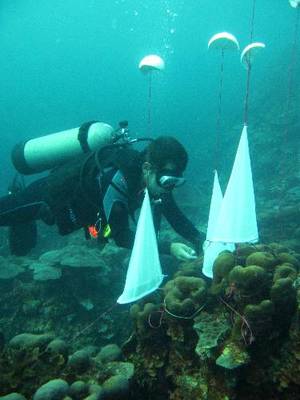 develop, I suppose they face challenges like avoiding predation, and finding a suitable surface to settle on, but what other potential difficulties do the coral larvae and the young polyps face?
develop, I suppose they face challenges like avoiding predation, and finding a suitable surface to settle on, but what other potential difficulties do the coral larvae and the young polyps face?
James - On top of all the natural challenges that they face, there's the addition of the, sort of, human impacts that almost all coral reefs around the world now are feeling. Aside from climate change, many reefs are experiencing very high sediment levels because of land reclamation and coastal development and so on. So, excess sediment, sort of, falling on top of the small coral polyps can very, very quickly smother it.
Another problem is overfishing. So many reefs around the world have lost the big herbivorous fish which do the job of cleaning a lot of the algae off the reef, macro algae, seaweeds and so on. And again when coral spat have to, sort of, compete for space with algae often the coral spat won't do as well, so that's a big challenge for them.
And then added on top of that there's the bigger problem of climate change.
There's not really much known about how climate change is affecting the coral reproduction. We know quite a lot about how it affects adult corals. And of course it's having a big affect because we're seeing lots of corals that are bleaching - that's when they loose their symbiotic algae and if they don't recover them relatively quickly they tend to die.
The few corals that are left, they're not going to have so many individuals that the can mate with. And so if you, if we go back to what we talked about earlier, these mass spawning events, I suppose the critical thing for those mass spawning events to be successful is to have lots and lots of individuals all spawning at once. But if the sort of critical mass of corals has suddenly dropped drastically, as you can imagine the chance of successful reproduction is going to be much, much lower.
Sarah - Because of the over production of gametes by the corals to buffer against things like predation, we could use the mass spawning to seed or repair damage to reefs. So either moving the collected spawn to new places or taking them back to the lab to rear them and then releasing them out into the field. How would that work?
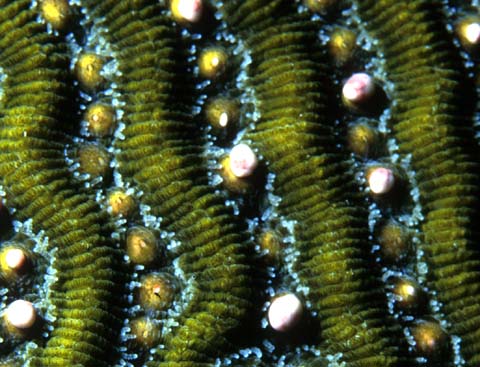 James - There's a couple of ways that this could be done. One way is to, sort of, harvest mass spawned slicks, just take billions and billions of embryos and exactly as you said if just to pump them down onto a bit of reef, maybe within some sort of enclosure, and try to just massively boost the amount of recruitment.
James - There's a couple of ways that this could be done. One way is to, sort of, harvest mass spawned slicks, just take billions and billions of embryos and exactly as you said if just to pump them down onto a bit of reef, maybe within some sort of enclosure, and try to just massively boost the amount of recruitment.
The other way is, again as you say, we could rear them in the lab so basically we try to sort of overcome that mortality bottleneck that you experience in the sea. And then settle then in a tank on land, and let the corals grow up to a size where they've got a good chance of surviving and then place them back on the reef.
So the first method, we've done some experiments with that and although, it works in the sense that we can boost recruitment, what we found is that if you look 6 months or 1 year down the line, the reefs that we have artificially seeded don't look any different from the reefs that have not had any seeding.
So at the moment that particular method doesn't look like it would be very successful.
The other method of rearing the corals in the lab for a period of time, potentially has some promise. And we've had a bit of success with that in designing some little substrates that are cheap and easy to make and we can settle corals onto them, we can rear them, and eventually we can plant them onto the reef.
And we've had some success with the technique. The main problem with it is that it's actually very expensive to do. So really, you know, if you have that kind of money to spend then you'd think that it might be much better to spend it on management initiatives, on protecting an area, methods that we know are more likely to be effective. At least at this stage. I think we need to do more research on these restoration techniques and it may in the future that they can have some really good uses and that there's some pretty exciting stuff that can be done.
I think whatever happens restoration is never going to be the only solution. We have to manage reef ecosystems effectively from the point of view of managing fisheries sensibly, coastal development, aquaculture development, and ultimately at the big scale managing climate change.
But I think we have to remain optimistic and we have to keep, sort of, pushing the message that reefs are really important, that they're threatened, that there have been some really good examples of reefs that when they are well managed they recover very well from disturbances.
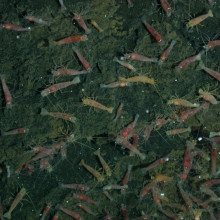
52:26 - Critter of the Month - Vent shrimp
Critter of the Month - Vent shrimp
with Tim Shank, Woods Hole Oceanographic Institution
Deep sea biologist Tim Shank picks a Critter of the Month with a few hidden surprises - a shrimp that lives on deep sea vents.
Tim - I'm Tim Shank. I'm a biologist at the Woods Hole Oceanographic Institution. And if I had to be a critter in our ocean I'd be a deep-sea animal, for sure. And I would be one that lived at hydrothermal vents and I think I would be a shrimp, actually.
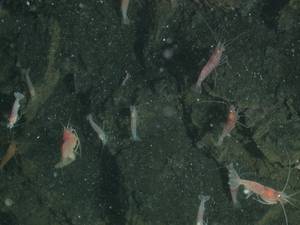 They don't live that long, I don't think, but the reality is these guys can move and they can move throughout the vent system. And what's so cool about them is that they farm their own bacteria in their gills. They hover around the vent water and these microbes love their gills, and the microbes grow and the animals just sit there and they farm off, they pick off the bacteria.
They don't live that long, I don't think, but the reality is these guys can move and they can move throughout the vent system. And what's so cool about them is that they farm their own bacteria in their gills. They hover around the vent water and these microbes love their gills, and the microbes grow and the animals just sit there and they farm off, they pick off the bacteria.
And they have this really cool adaptation: they don't have eyes like normal shrimp. Okay, they've lost their eyes, they've lost their eye stalks. And instead they have this plate that sits on the front of them where their eyes would normally be. And their eye has migrated back to on their backs.
We believe that they can see with this little organ on their back that allows them to see black body radiation - the heat coming from the vents. We think they can image that and see it.
So how cool would that be, to fly around the deep-sea, looking for hot spots like that, looking for a dim glow of light that's a hydrothermal vent. You roll up to the vent and you have nice warm bath of water and you can farm microbes right there. I think that would be so cool to be one of those.
Find out more
Rimicaris exoculata on Sealife base
Tim Shank's lab at Woods Hole Oceanographic Institution
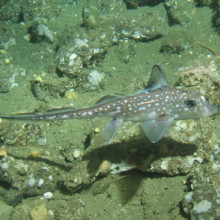
54:02 - Mysterious shark cousins
Mysterious shark cousins
with Matt Gollock, Zoological Society of London
Chimaeras are little known relatives of sharks that get up to some odd things in the deep sea.
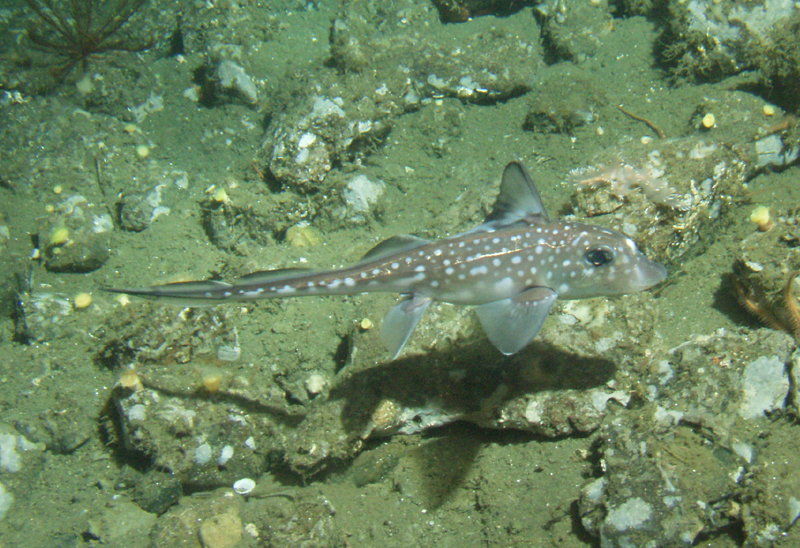 Find out more:
Find out more:
EDGE - Evolutionary Distinct & Globally Endangered, ZSL
Matt - My name is Matt Gollock. I am the assistant manager of the international marine and freshwater conservation programme at the Zoological Society of London. And the chimaeras are probably what I would describe as the forgotten cousin of the shark and ray.
We know very, very little about chimaeras in comparison to both the sharks and rays.
Chimaeras are very odd looking creatures. And chimaera in Greek mythology actually means a creature that's created from other bits of animals, which when you look at a chimaera you can actually sort of believe that.
And, while chimaera is a sort of a group term for these fish, within that there's individual species that are known as rabbit fish, rat fish, elephant fish. So there's a range of different names for different chimaera species.
The thing we can generally say about chimaeras is they mainly live at depth, so anything down to about 2500 m.
As I mentioned they're related to the sharks and rays and all three of these different groups of animals, the sharks, rays, and chimaeras, have skeletons that are made of cartilage rather than bone.
And if I was to sort of describe an average chimaera, I'd probably first say there's no such thing as an average chimaera, but when you get to the head end that's where it kind of gets really interesting because they often, sharks, rays, and chimaeras, all use electrosense to detect their prey. And the chimaeras have some very unusual modifications of their snout to aid this. Some of them have very, very long paddle shaped ones.
This fact just, I still sort of have trouble imagining the mechanics of this but the males actually have a retractable sex organ on their head. And they have traditional sex organs as well, but they seem to have this other one as well. And to my knowledge I don't know if anyone's actually seen it in use, but it is something that sort of slightly boggles my mind.
I guess, my interest as part of the Zoological Society of London is obviously around conservation. And this is what the Edge Sharks project is gearing up to address. And as I mentioned before we know very little about chimaera. Any species that we don't know much about is potentially vulnerable to man's activities in the oceans.
If we don't know how what we're doing is affecting fish, it's going to be quite difficult to protect them. SO in reality a lot of basic conservation action in relation to chimaeras might be simply in relation to gathering more information on their behaviour and their distribution.
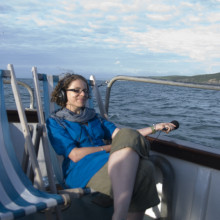
56:43 - Behind the scenes at Naked Oceans
Behind the scenes at Naked Oceans
with Helen Scales, Sarah Castor-Perry
Looking back on the first year of making Naked Oceans, we crack open the outtakes reel and reveal a little of what goes on behind the scenes when Helen and Sarah make the show.
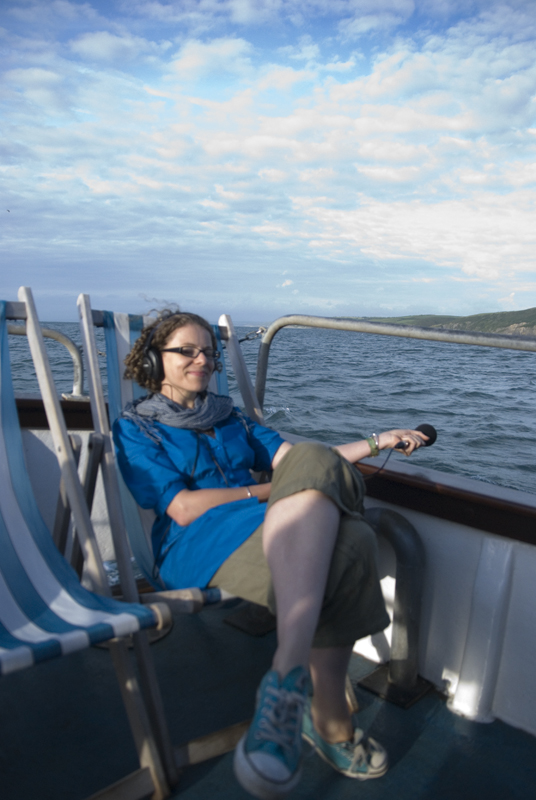









Comments
Add a comment